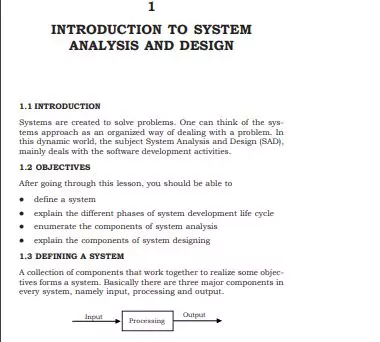‘Structured Systems Analysis And Design PDF’ PDF Quick download link is given at the bottom of this article. You can see the PDF demo, size of the PDF, page numbers, and direct download Free PDF of ‘Systems Analysis and Design PDF Notes’ using the download button.
Information Systems Analysis and Design Book PDF Free Download

System Analysis and Design
Systems are created to solve problems. The systems approach provides an organized way to solve a problem. In our dynamic world, System Analysis and Design (SAD) is mainly related to software development activities.
After reading this, you should be able to:
- define a system
- Explain the stages of the systems development life cycle
- List the components of system analysis
- Explain the components of system design
Defining A System
A system is a collection of components that work together to achieve objectives. The three major components of any system are input, processing and output. In a system, components are connected and interdependent. For example, the human body is a completely natural system. We also operate within many man-made systems, such as political, economic, and educational systems. A well-designed system produces outputs by processing appropriate inputs, with an additional element of feedback control to meet the objectives of the system.
System Life Cycle
The system life cycle is the organizational process of developing and maintaining systems over time. It establishes a project plan by outlining the required processes and sub-processes. The system development life cycle connects various activities. It also refers to the software development life cycle in systems analysis terminology.
Stages of System Development Life Cycle:
- Preliminary study – Brief investigation of the existing system to understand what it does. It involves preparing a system proposal based on problem definition, study objectives, terms of reference, constraints, expected benefits, etc. based on user needs.
- Feasibility study – evaluates the system proposal for functionality, meeting requirements, resource utilization, and cost-effectiveness. Assesses technical, operational, economic, and scheduling feasibility. Defines the resources needed for further investigation. Result in feasibility report submitted to management.
- Detailed systems study – in-depth investigation of system operations and their internal/external relationships. The current system collects data on files, decisions, and transactions. Uses interviews, observations, and questionnaires. Document findings in data flow diagrams, data dictionaries, specifications, etc.
- System Analysis – Defines specifications for what the new system should achieve based on user needs. Includes functional hierarchy, relationships, networks, and entity attributes.
The cycle continues through system design, coding, testing, implementation, and maintenance, provided the feasibility study is approved.
| Author | – |
| Language | English |
| No. of Pages | 10 |
| PDF Size | 0.1 MB |
| Category | Engineering |
| Source/Credits | nios.ac.in |
Systems Analysis and Design Notes PDF Free Download
